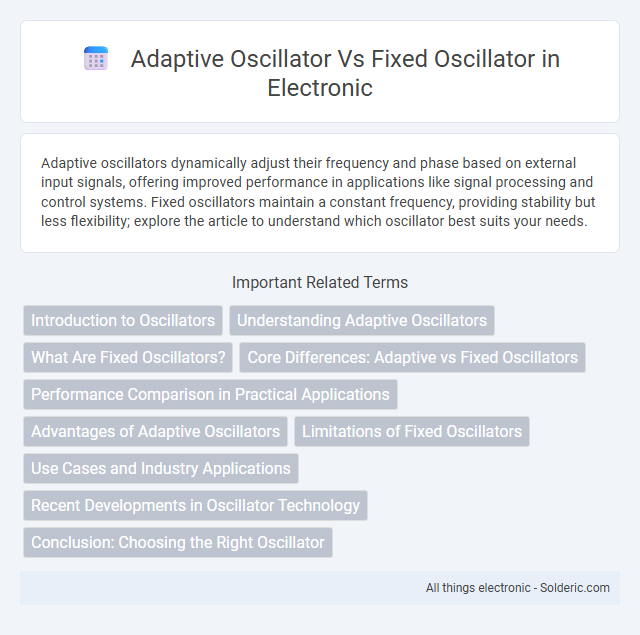Adaptive oscillators dynamically adjust their frequency and phase based on external input signals, offering improved performance in applications like signal processing and control systems. Fixed oscillators maintain a constant frequency, providing stability but less flexibility; explore the article to understand which oscillator best suits your needs.
Comparison Table
| Feature | Adaptive Oscillator | Fixed Oscillator |
|---|---|---|
| Frequency Stability | Dynamic frequency adjustment ensures stable output under varying conditions | Constant frequency with potential drift due to environmental factors |
| Frequency Range | Wide adjustable frequency range | Limited to a fixed, predetermined frequency |
| Application | Ideal for adaptive systems like communication, sensors, and signal processing | Best suited for applications requiring consistent frequency like clocks and reference signals |
| Power Consumption | Potentially higher due to adaptive control circuitry | Generally lower power usage |
| Complexity | Higher complexity with feedback control loops | Simpler design and implementation |
| Cost | Higher cost due to advanced components | Lower cost and easier manufacturing |
| Performance in Noise | Better resilience due to adaptive tuning | More susceptible to noise and drift |
Introduction to Oscillators
Oscillators are electronic circuits that generate periodic signals, essential for clocks, radios, and signal processing. Adaptive oscillators adjust their frequency based on input or environmental changes, enhancing signal synchronization and stability. Fixed oscillators, in contrast, provide a constant frequency output, ideal for applications requiring stable, unchanging signals.
Understanding Adaptive Oscillators
Adaptive oscillators dynamically adjust their frequency and phase based on input signals, enhancing synchronization in complex systems such as neural networks and signal processing applications. Unlike fixed oscillators that maintain a constant frequency regardless of external stimuli, adaptive oscillators optimize performance by learning and adapting to changing environments. This flexibility enables improved robustness and accuracy in time-series prediction, control systems, and brain-inspired computing models.
What Are Fixed Oscillators?
Fixed oscillators generate a constant frequency signal, maintaining stable and precise output that is essential for applications like clock generation and communication systems. These oscillators rely on fixed components such as crystals or resonators to ensure minimal frequency drift over time and temperature variations. Your choice of a fixed oscillator guarantees reliable timing performance when frequency adaptability is not required.
Core Differences: Adaptive vs Fixed Oscillators
Adaptive oscillators dynamically adjust their frequency and phase based on feedback from the input signal, enabling precise tracking of non-stationary or time-varying signals. Fixed oscillators maintain a constant frequency and phase, making them suitable for stable signal environments but less effective in adapting to signal changes. The core difference lies in adaptability: adaptive oscillators provide enhanced flexibility and accuracy for varying signals, while fixed oscillators offer simplicity and stability for consistent frequency applications.
Performance Comparison in Practical Applications
Adaptive oscillators dynamically adjust frequency and phase to maintain synchronization with varying signals, offering superior performance in noisy or time-varying environments compared to fixed oscillators that operate at constant frequencies. In communication systems, adaptive oscillators enhance signal recovery and reduce phase error, improving data integrity and reducing bit error rates. Fixed oscillators provide stability and low complexity in applications with consistent frequency requirements but lack flexibility, making adaptive designs preferable for real-time adaptive filtering and signal tracking tasks.
Advantages of Adaptive Oscillators
Adaptive oscillators offer superior frequency stability and improved noise reduction compared to fixed oscillators, enabling precise signal tracking in dynamic environments. Their ability to self-tune based on input signal variations enhances performance in wireless communication systems and radar applications. This adaptability reduces phase errors and power consumption, making adaptive oscillators ideal for low-power, high-accuracy electronic devices.
Limitations of Fixed Oscillators
Fixed oscillators exhibit limitations such as a lack of frequency flexibility, making them unsuitable for applications requiring dynamic tuning or frequency modulation. Their performance can degrade in environments with temperature fluctuations or voltage variations due to inability to adapt resonance characteristics. These constraints reduce efficiency in modern communication systems where frequency agility and stability are critical.
Use Cases and Industry Applications
Adaptive oscillators excel in telecommunications and radar systems, where dynamic frequency adjustment enhances signal clarity and interference resistance. Fixed oscillators find widespread application in consumer electronics, such as clocks and radios, where stable, precise frequencies are crucial for consistent performance. The preference for adaptive or fixed oscillators depends on the specific industry requirements for frequency stability versus flexibility in rapidly changing environments.
Recent Developments in Oscillator Technology
Recent developments in oscillator technology highlight a shift from fixed oscillators to adaptive oscillators, which dynamically adjust frequency in response to environmental changes and signal variations. Adaptive oscillators enhance signal stability and accuracy in communication systems by compensating for temperature fluctuations and component aging, unlike fixed oscillators that maintain a constant frequency regardless of external factors. Your choice between these technologies impacts device performance, with adaptive oscillators offering improved reliability in modern wireless and IoT applications.
Conclusion: Choosing the Right Oscillator
Adaptive oscillators offer enhanced flexibility by automatically adjusting frequency in response to environmental changes, making them ideal for dynamic systems requiring precise synchronization. Fixed oscillators provide stable, consistent output frequencies suitable for applications with predictable conditions and minimal variability. Selecting the right oscillator depends on balancing the need for frequency stability against the advantage of real-time adaptability based on the specific use case requirements.
Adaptive oscillator vs Fixed oscillator Infographic

 solderic.com
solderic.com